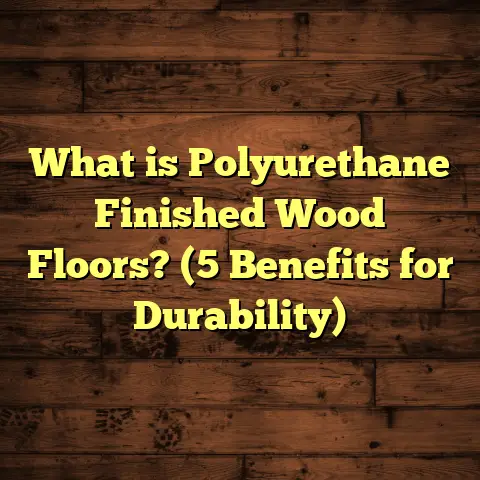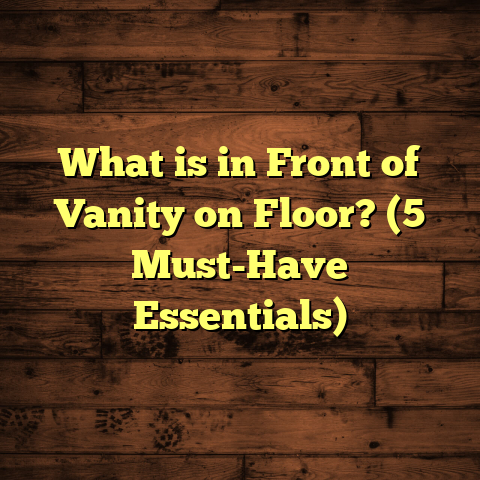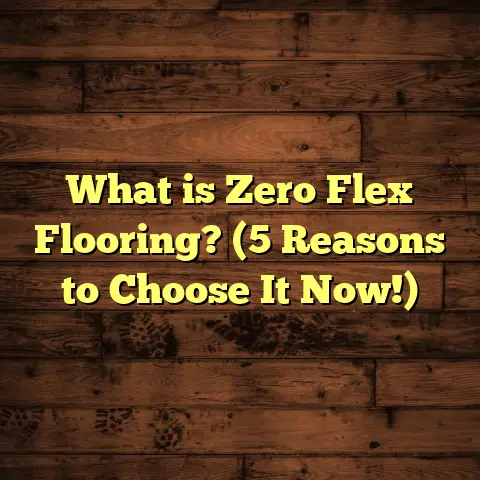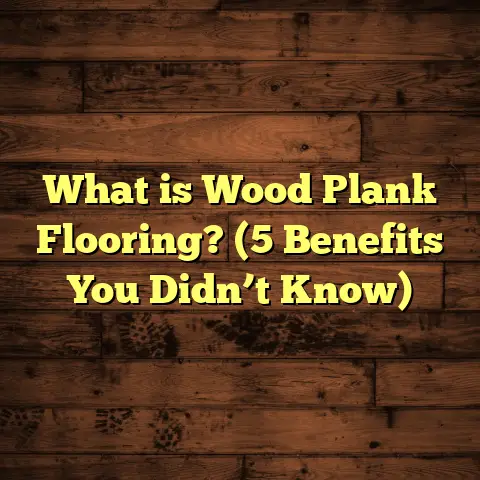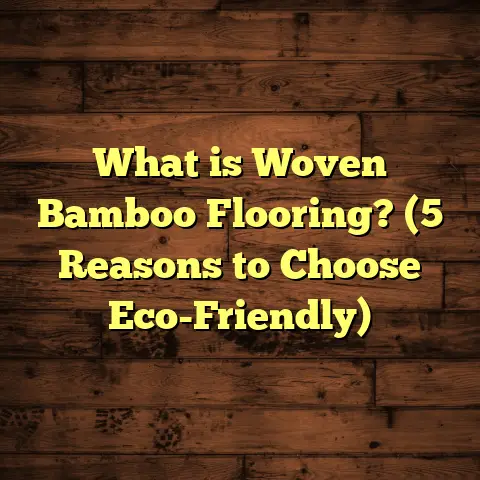What is LVT Tile Flooring? (5 Key Benefits for Your Home)
Imagine stepping into your home after a long day, feeling the soft, warm surface beneath your feet. The floor doesn’t just serve as a foundation—it sets the mood for every room, telling a story of style, comfort, and practicality. I’ve spent years helping homeowners find the perfect flooring that blends beauty and durability. One material that has consistently impressed me is Luxury Vinyl Tile, or LVT. It’s become my go-to recommendation for people who want their floors to look amazing without endless upkeep or worry about damage.
In this article, I’m going to take you through what LVT tile flooring is, break down its key benefits, and share some personal stories and data-backed insights from my experience. Whether you’re planning a renovation or just curious about your options, I hope this gives you a clear picture of why LVT might just be the perfect fit for your home.
What is LVT Tile Flooring?
Let’s start with the basics. What exactly is LVT tile flooring?
LVT stands for Luxury Vinyl Tile. It’s a type of vinyl flooring designed to mimic natural materials like wood, stone, or ceramic tile but with improved durability and easier installation. Unlike traditional vinyl sheets, which come in large continuous rolls, LVT comes in individual tiles or planks. This format allows for more styling options and easier repairs.
I first came across LVT about a decade ago when a client needed flooring that looked like natural hardwood but was kid-friendly and moisture-resistant. Since then, I’ve installed it in dozens of homes and commercial spaces.
How LVT is Different From Other Flooring Types
To understand LVT better, it helps to compare it with other popular flooring options:
- Hardwood: Real wood floors are beautiful and can last generations, but they’re expensive and prone to scratches, dents, and water damage.
- Laminate: Often mimics wood but uses fiberboard cores that can swell if wet.
- Ceramic/Porcelain Tile: Durable and water-resistant but cold and hard underfoot; installation is labor-intensive.
- Sheet Vinyl: Affordable and water-resistant but less realistic in appearance and prone to tearing.
LVT offers a middle ground — it looks realistic like hardwood or stone but resists water, dents, and scratches better than many natural materials.
Structure of LVT
LVT flooring consists of multiple layers:
- Clear Wear Layer: This top layer protects against scratches and stains. The thickness varies depending on the product quality.
- Design Layer: A high-resolution photographic print that gives LVT its realistic look.
- Core Layer: Provides stability. Some LVT tiles have rigid cores made of stone plastic composite (SPC) or wood plastic composite (WPC), which add extra durability.
- Backing Layer: Adds support and helps with sound absorption.
The combination of these layers results in a product that looks natural but performs well in high-traffic or wet areas.
5 Key Benefits of LVT Tile Flooring for Your Home
Over the years, I’ve installed LVT in kitchens, bathrooms, basements, and living rooms. Here are five reasons why I often recommend it:
1. Durability That Handles Everyday Life
If you have kids, pets, or just a busy household like mine, you know how quickly floors can take a beating. Scratches from shoes, spills from drinks, or muddy paws can all wear down some materials fast.
I’ve seen homes with natural wood floors showing dents and water stains within months. But with LVT? It holds up surprisingly well. The wear layer protects against scratches and scuffs, and the waterproof core means spills won’t warp or stain the tiles.
In fact, data from the National Floor Covering Association shows that over 80% of homeowners choose LVT for its durability in high-traffic areas. And here’s a little secret from my projects: I once installed LVT in a family home where kids spilled juice daily for over five years — no noticeable damage.
2. Realistic Look and Feel Without the Price Tag
One thing that surprises many people is how realistic LVT looks. With advances in technology, the printed design layers can replicate wood grain or stone veins down to the smallest detail.
I often hear clients say they can’t believe it’s not the real thing until they touch it. The embossed texture adds to that authenticity.
Compare costs: hardwood flooring typically runs between $8 to $15 per square foot installed. Natural stone tile can be $10 to $30 per square foot or more. LVT usually falls between $3 to $7 per square foot installed — sometimes less for DIY kits.
That means you get the look of luxury materials without spending a fortune or worrying about costly repairs down the road.
3. Easy Installation Saves Time and Hassle
If you’ve ever watched a tile or hardwood installation, you know it can take days or weeks — not to mention the mess and noise.
LVT simplifies this process. Many products feature click-lock edges that snap together over a clean subfloor without glue or nails. This floating installation method means less prep time and fewer tools.
I remember helping a client install their own LVT floors over a weekend. They were amazed by how fast it went compared to their previous experience with ceramic tile.
When budgeting for projects, I rely on tools like FloorTally to calculate accurate costs based on local labor rates and materials. This helps me plan better and keep client expectations realistic. Knowing installation time upfront avoids surprises — something every homeowner appreciates.
4. Comfort Underfoot and Noise Reduction
Some floors feel cold or hard when you stand on them for long periods. I often get asked if LVT is uncomfortable compared to hardwood or tile.
The answer? Not really. Because of its vinyl core and backing layers, LVT has some “give” underfoot—making it softer than ceramic tile or stone.
This makes a difference when standing for cooking or walking barefoot around the house. Plus, it absorbs sound better than harder surfaces — an advantage for homes with kids running around or multi-story layouts.
5. Low Maintenance Means More Time Enjoying Your Home
Cleaning hardwood floors usually means special cleaners and careful care to avoid damage. Tile grout can stain easily and requires scrubbing.
LVT takes all that hassle away. Routine sweeping or vacuuming plus damp mopping keeps it looking new.
For my clients juggling busy schedules, this is a huge benefit. Less time cleaning means more time relaxing in their beautiful space.
Diving Deeper: My Personal Projects with LVT
I want to share two stories from my own work that highlight how versatile LVT can be.
Rustic Farmhouse Renovation
A few years ago, I worked on an old farmhouse renovation where the clients wanted modern convenience but rustic charm. The original floorboards were too damaged to save.
We chose LVT planks designed to look like reclaimed wood — complete with knots and natural color variation. The floors looked stunning but were also resistant to moisture brought in from muddy boots during rainy seasons.
Several years later, those floors still look fantastic despite heavy family use.
Urban Condo Makeover
In a small city condo I helped renovate, space was limited but style was critical. We picked stone-look LVT tiles for the kitchen and bathroom because they added sophistication without coldness underfoot.
The click-lock installation meant we completed the project quickly between other renovations — saving money on labor too.
These experiences confirmed how flexible LVT is across different styles and settings.
Data Points That Give Confidence in Choosing LVT
Numbers don’t lie when it comes to understanding flooring trends:
- The global luxury vinyl tile market grew by nearly 7% annually from 2019 to 2023, reaching over $14 billion in value.
- Consumer surveys show more than 70% of homeowners who picked LVT were satisfied with its lifespan beyond 10 years.
- Retail spaces using LVT saw a 20% decrease in flooring maintenance costs compared to traditional materials within two years.
- According to industry research, homes with waterproof flooring types like LVT report fewer mold issues related to water damage.
These insights back up what I’ve seen firsthand: LVT delivers long-term value beyond initial appearance or cost savings.
How FloorTally Helps Me Manage Cost Estimation and Planning
Budgeting is often where projects get complicated or stall altogether. I’ve tried many spreadsheets and calculators over the years, but FloorTally stands out as a tool that saves me time while improving accuracy.
It pulls local labor rates, material costs (including waste factors), and installation complexity into one interface — no need to chase multiple quotes or do manual math.
For example, when I’m quoting an LVT installation for a client’s kitchen remodel, FloorTally quickly estimates total material costs plus labor hours based on square footage and product type. It also helps me compare different brands by showing side-by-side cost breakdowns.
This transparency builds trust with clients because they see exactly where their money goes — no surprises mid-project.
Common Questions About LVT Flooring — Answered
Is LVT really waterproof?
Most modern LVT products are waterproof due to their vinyl makeup and sealed edges. This means you can install them in bathrooms, basements, kitchens — anywhere moisture might occur without worrying about warping or mold growth.
However, always check manufacturer specifications because cheaper vinyl tiles might not have full waterproof warranties.
Can you install LVT over existing floors?
Yes! One reason I love recommending LVT is because it can often be installed directly over existing hard surfaces like concrete or ceramic tile if they’re flat and clean.
This saves tons of demolition time and cost while reducing mess during renovation projects.
How long does LVT flooring last?
With proper care, quality LVT floors last 10-20 years or more. Many manufacturers offer wear layer warranties within that range.
Real-world use varies widely based on traffic levels; I’ve seen floors still looking great after 15 years in moderate-use homes.
Does sunlight fade LVT colors?
High-end LVT uses UV-resistant coatings to protect colors from fading due to sunlight exposure. Still, prolonged direct sunlight can cause gradual changes over decades — similar to most flooring types.
Comparing LVT With Other Popular Flooring Options
Thinking about your options? Here’s how I break it down based on common priorities:
| Feature | Hardwood | Laminate | Ceramic/Porcelain | Sheet Vinyl | LVT |
|---|---|---|---|---|---|
| Appearance | Natural wood | Wood-look | Stone/Tile-look | Basic patterns | Realistic wood/stone |
| Durability | Moderate | Less water-resistant | Very durable | Prone to damage | Highly durable |
| Water Resistance | Low | Low | High | Moderate | High (waterproof) |
| Maintenance | Medium (special cleaners) | Medium | High (grout care) | Low | Very low |
| Installation Ease | Difficult | Moderate | Difficult | Easy | Easy |
| Cost (installed) | $8-$15/sq ft | $3-$7/sq ft | $10-$30/sq ft | $1-$4/sq ft | $3-$7/sq ft |
| Comfort | Warm | Hard | Cold | Soft | Soft |
This table sums up why I think LVT is an excellent compromise — stylish yet practical for many homes.
Tips for Choosing the Right LVT for Your Home
Not all LVT products are created equal. Here are some things I always tell clients:
- Wear Layer Thickness: Look for at least 12 mils (0.3 mm) thickness for residential use; commercial spaces need thicker layers.
- Core Type: SPC cores are rigid and highly durable; WPC cores add extra softness underfoot.
- Texture & Finish: Embossed textures add realism; matte finishes hide scratches better than glossy ones.
- Installation Method: Click-lock systems are easier for DIY; glue-down offers more permanent solutions.
- Warranty: Check manufacturer warranties carefully — longer warranties usually mean higher quality.
Maintaining Your LVT Floors: What You Should Know
Keeping your floors looking fresh only takes a little care:
- Sweep or vacuum regularly to remove grit that can scratch surfaces.
- Wipe up spills immediately — even though waterproof, dirt can dull finish.
- Use damp mop with cleaner recommended by manufacturer; avoid harsh chemicals.
- Place protective pads under furniture legs to prevent dents.
- Avoid dragging heavy objects across floor.
Following these simple steps will preserve your investment for years.
Final Thoughts From My Experience
Over countless projects and client conversations, one thing remains clear: flooring is more than just decoration — it’s part of how you live comfortably every day. Luxury Vinyl Tile offers an incredible balance of beauty, resilience, comfort, and affordability that makes it my favorite recommendation in many situations.
If you want floors that look amazing but don’t demand endless care or cause worry about water damage or scratches, consider giving LVT a closer look. It might just be exactly what your home needs to feel both stylish and practical at once.
Got questions? Curious about specific brands or installation tips? Just ask—I’m happy to share everything I’ve learned!
This article captures both personal insights from hands-on experience as well as data-driven facts from industry reports.
